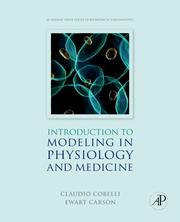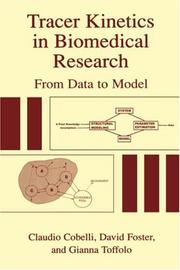| Listing 1 - 10 of 12 | << page >> |
Sort by
|

ISBN: 9780080559988 0080559980 1281188964 9786611188962 0121602400 9781281188960 9780121602406 Year: 2008 Publisher: Amsterdam : Elsevier,
Abstract | Keywords | Export | Availability | Bookmark
 Loading...
Loading...Choose an application
- Reference Manager
- EndNote
- RefWorks (Direct export to RefWorks)
This unified modeling textbook for students of biomedical engineering provides a complete course text on the foundations, theory and practice of modeling and simulation in physiology and medicine. It is dedicated to the needs of biomedical engineering and clinical students, supported by applied BME applications and examples. Developed for biomedical engineering and related courses: speaks to BME students at a level and in a language appropriate to their needs, with an interdisciplinary clinical/engineering approach, quantitative basis, and many applied examples to enhance learning
Human medicine --- Human physiology --- Physiology --- Medicine --- Mathematical models. --- Biomathematics --- Health Workforce
Book
ISBN: 0124095259 0124115578 9780124095250 9781306195683 1306195683 9780124115576 Year: 2014 Publisher: London : Elsevier,
Abstract | Keywords | Export | Availability | Bookmark
 Loading...
Loading...Choose an application
- Reference Manager
- EndNote
- RefWorks (Direct export to RefWorks)
Modelling Methodology for Physiology and Medicine, Second Edition, offers a unique approach and an unprecedented range of coverage of the state-of-the-art, advanced modeling methodology that is widely applicable to physiology and medicine.
Physiology --- Medicine --- Mathematical models. --- Biomathematics --- Health Workforce
Book
ISBN: 0128158050 0128157569 9780128157565 9780128157565 9780128158050 Year: 2019 Publisher: London, England : Academic Press,
Abstract | Keywords | Export | Availability | Bookmark
 Loading...
Loading...Choose an application
- Reference Manager
- EndNote
- RefWorks (Direct export to RefWorks)
Physiology --- Mathematical models. --- Medicine --- Health Workforce

ISBN: 1281036137 9786611036133 0080511902 0121602451 9780121602451 9780080511900 9781281036131 Year: 2001 Publisher: San Diego Academic Press
Abstract | Keywords | Export | Availability | Bookmark
 Loading...
Loading...Choose an application
- Reference Manager
- EndNote
- RefWorks (Direct export to RefWorks)
Modelling Methodology for Physiology and Medicine offers a unique approach and an unprecedented range of coverage of the state-of-the-art, advanced modelling methodology that is widely applicable to physiology and medicine. The book opens with a clear and integrated treatment of advanced methodology for developing mathematical models of physiology and medical systems. Readers are then shown how to apply this methodology beneficially to real-world problems in physiology and medicine, such as circulation and respiration.Builds upon and enhances the readers existing knowled
Physiology --- Medicine --- Mathematical models. --- Biomathematics --- Health Workforce
Digital
ISBN: 9780080559988 0080559980 9780080559988 1281188964 9781281188960 Year: 2008 Publisher: Boston Elsevier/Academic Press
Abstract | Keywords | Export | Availability | Bookmark
 Loading...
Loading...Choose an application
- Reference Manager
- EndNote
- RefWorks (Direct export to RefWorks)
This unified modeling textbook for students of biomedical engineering provides a complete course text on the foundations, theory and practice of modeling and simulation in physiology and medicine. It is dedicated to the needs of biomedical engineering and clinical students, supported by applied BME applications and examples. Developed for biomedical engineering and related courses, with an interdisciplinary clinical/engineering approach, quantitative basis, and many applied examples to enhance learning Delivers a quantitative approach to modeling and also covers simulation Case studies and engineering applications from BME, plus end of chapter exercises and Instructors manual.
Digital
ISBN: 0124095259 9780124095250 9781306195683 1306195683 Year: 2014 Publisher: Amsterdam Elsevier
Abstract | Keywords | Export | Availability | Bookmark
 Loading...
Loading...Choose an application
- Reference Manager
- EndNote
- RefWorks (Direct export to RefWorks)
Modelling Methodology for Physiology and Medicine, Second Edition, offers a unique approach and an unprecedented range of coverage of the state-of-the-art, advanced modeling methodology that is widely applicable to physiology and medicine. The second edition, which is completely updated and expanded, opens with a clear and integrated treatment of advanced methodology for developing mathematical models of physiology and medical systems. Readers are then shown how to apply this methodology beneficially to real-world problems in physiology and medicine, such as circulation and respiration.
Digital
Year: 2019 Publisher: London, United Kingdom Academic Press, an imprint of Elsevier
Abstract | Keywords | Export | Availability | Bookmark
 Loading...
Loading...Choose an application
- Reference Manager
- EndNote
- RefWorks (Direct export to RefWorks)

ISBN: 9780121602451 0121602451 9780080511900 0080511902 1281036137 9781281036131 9786611036133 Year: 2001 Publisher: San Diego Academic Press
Abstract | Keywords | Export | Availability | Bookmark
 Loading...
Loading...Choose an application
- Reference Manager
- EndNote
- RefWorks (Direct export to RefWorks)
Modelling Methodology for Physiology and Medicine offers a unique approach and an unprecedented range of coverage of the state-of-the-art, advanced modelling methodology that is widely applicable to physiology and medicine. The book opens with a clear and integrated treatment of advanced methodology for developing mathematical models of physiology and medical systems. Readers are then shown how to apply this methodology beneficially to real-world problems in physiology and medicine, such as circulation and respiration.Builds upon and enhances the readers existing knowled
Human physiology --- Human medicine --- Physiology --- Medicine --- Mathematical models.

ISBN: 1280042974 9786610042975 0306468336 9780306464270 0306464276 9780306468339 Year: 2001 Publisher: New York, New York : Plenum Press,
Abstract | Keywords | Export | Availability | Bookmark
 Loading...
Loading...Choose an application
- Reference Manager
- EndNote
- RefWorks (Direct export to RefWorks)
1. Introduction. 2. Fundamentals of Tracer Kinetics. 3. The Noncompartmental Model of Multipool Systems. 4. The Compartmental Model. 5. Identifiability of the Tracer Model. 6. Using the Tracer Model to Estimate Kinetic Parameters. 7. Compartmental Versus Noncompartmental Kinetic Parameters. 8. Parameter Estimation: Some Fundamentals of Regression Analysis. 9. Parameter Estimation in Noncompartmental Models. 10. Parameter Estimation in Compartmental Models. 11. Precursor-Product Models. Appendices. Index.
Radioactive tracers in biochemistry --- Pharmacokinetics --- Mathematics. --- Pharmacokinetics - Mathematics. --- Radioactive tracers in biochemistry. --- Mechanical Phenomena --- Engineering. --- Physical chemistry. --- Mathematical models. --- Biomathematics. --- Statistics. --- Biomedical engineering. --- Biomedical Engineering. --- Statistics for Life Sciences, Medicine, Health Sciences. --- Mathematical and Computational Biology. --- Physical Chemistry. --- Mathematical Modeling and Industrial Mathematics. --- Chemistry, Physical organic. --- Biomedical Engineering and Bioengineering. --- Statistics . --- Models, Mathematical --- Simulation methods --- Chemistry, Theoretical --- Physical chemistry --- Theoretical chemistry --- Chemistry --- Biology --- Mathematics --- Statistical analysis --- Statistical data --- Statistical methods --- Statistical science --- Econometrics --- Clinical engineering --- Medical engineering --- Bioengineering --- Biophysics --- Engineering --- Medicine
Book
ISBN: 9780471086604 0471086606 Year: 1983 Publisher: New York: Wiley,
Abstract | Keywords | Export | Availability | Bookmark
 Loading...
Loading...Choose an application
- Reference Manager
- EndNote
- RefWorks (Direct export to RefWorks)
Endocrinology --- Metabolism --- Compartmental analysis (Biology)
| Listing 1 - 10 of 12 | << page >> |
Sort by
|

 Search
Search Feedback
Feedback About UniCat
About UniCat  Help
Help News
News